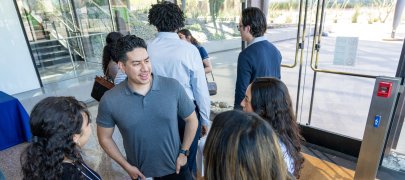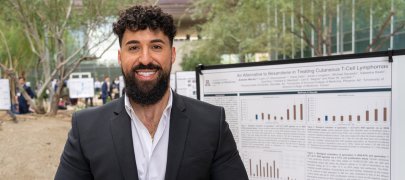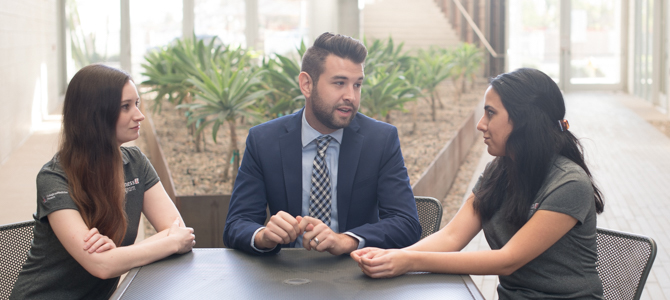
College's Wellness Program Aspires to Promote Healthy, Help-Seeking Habits

Medical school is not a sprint, but sometimes it can feel like one.
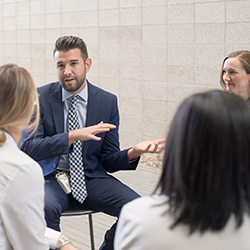
The program, initially started by Stephanie Smith, EdD, director of Student Development, is headed by Daniel Drane, EdD, assistant director of Student Wellness and Engagement.
Its focus is to assist students and physicians in taking care of themselves, so they can, in turn, help others. It does so through fun and interactive programming like the Wellness Olympics, Fall Festival, Mental Health Awareness Week and therapy dog days, as well as by engaging students during Capstones and Intersessions in discussions on topics like anxiety, depression, burnout and suicide prevention.
Medical school has the potential to exacerbate depression and anxiety, which can lead to burnout. Drane said it’s important for the college to create opportunities for students to not only learn more about these issues, but understand there is a place they can go to practice techniques to prevent them should they arise.
The program “is a hub for helping students learn about the things they may be experiencing for the first time in medical school,” he said.
The key is acknowledging that many medical students are ill equipped to handle mounting pressures because it might be their first real experience with them.
“Medical students are all very successful coming in. They are top of their class, have participated in many extracurricular activities and have excelled academically. They have been vying for positions, interviewed and they have gotten through the process,” Drane said. “Then they get here, and they have an entire class full of people who are highly successful in doing all of this work and for the first time in their life, their workload is going to be greater than anything they probably have experienced before. We call it drinking from a fire hose.”
That proverbial fire hose can be daunting, and may require a major alteration in both a student’s study habits and how they manage their time.
That’s why Drane finds it crucial to begin implementing wellness practices now, as opposed to later. “Wellness and well-being is sometimes seen as an afterthought for people, especially for physicians who are so used to taking care of other people. Being well is constant maintenance and something you need to do throughout your life, not something you just want to do when you are in crisis.”
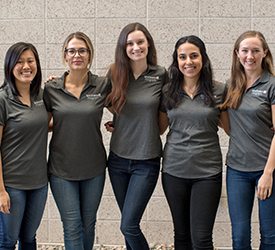
Drane has acknowledged that with its expanded scope, helping students maintain wellness is no longer “a one-man job.” To that end, he assembled the program’s Wellness Executive Committee — second-year students Jaimei Zhang, Agnieszka Radziszewska, Amy Capone, Bibinaz Eghtedari and Kathleen Hanlon (pictured in order to the left) — who assist him.
Eghtedari’s involvement is a reflection of the school: “Everyone genuinely wants us to succeed, and I think the Wellness Program really demonstrates that.” She is taking an active role because, with the rigors of medical school, she said, “it is imperative to implement self-care and personal wellness within our daily schedules in order to create balance and maintain our physical and emotional health."
In the end, it is all about striking that proper balance, though that is not the ideal word Drane would use to describe it: “I try to avoid the word balance because no one is ever balanced. There is always going to be some give and take.”
That is where the program comes in. It reminds students to allow themselves that necessary break when their tank is nearing empty. After all, being stressed is the antithesis of being healthy; and as aspiring physicians, the mission of the students is to ensure the health of others. It’s only fair they know how to ensure their own, as well.
Article by: Tom Kelly
Media Contact:
Marian Frank
Phone: 602-827-2022
Topics
About the College
Founded in 2007, the University of Arizona College of Medicine – Phoenix inspires and trains exemplary physicians, scientists and leaders to optimize health and health care in Arizona and beyond. By cultivating collaborative research locally and globally, the college accelerates discovery in a number of critical areas — including cancer, stroke, traumatic brain injury and cardiovascular disease. Championed as a student-centric campus, the college has graduated more than 800 physicians, all of whom received exceptional training from nine clinical partners and more than 2,700 diverse faculty members. As the anchor to the Phoenix Bioscience Core, which is projected to have an economic impact of $3.1 billion by 2025, the college prides itself on engaging with the community, fostering education, inclusion, access and advocacy.
